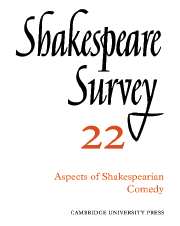Book contents
- Frontmatter
- Old and New Comedy
- An Approach to Shakespearian Comedy
- Shakespeare, Molière, and the Comedy of Ambiguity
- Comic Structure and Tonal Manipulation in Shakespeare and Some Modern Plays
- Laughing with the Audience: ‘The Two Gentlemen of Verona’ and the Popular Tradition
- Shakespearian and Jonsonian Comedy
- Two Magian Comedies: ‘The Tempest’ and ‘The Alchemist’
- ‘Thou that beget’st him that did thee beget’: Transformation in ‘Pericles’ and ‘The Winter’s Tale’
- The Words of Mercury
- Why Does it End Well? Helena, Bertram, and The Sonnets
- Some Dramatic Techniques in ‘The Winter’s Tale’
- Clemency, Will, and Just Cause in ‘Julius Caesar’
- Thomas Bull and other ‘English Instrumentalists’ in Denmark in the 1580s
- Shakespeare in the Early Sydney Theatre
- The Reason Why: The Royal Shakespeare Season 1968
- The Year's Contributions to Shakespearian Study 1 Critical Studies
- 2 Shakespeare’s Life, Times and Stage
- 3 Textual Studies
- Index
- Plate Section
Laughing with the Audience: ‘The Two Gentlemen of Verona’ and the Popular Tradition
Published online by Cambridge University Press: 28 March 2007
- Frontmatter
- Old and New Comedy
- An Approach to Shakespearian Comedy
- Shakespeare, Molière, and the Comedy of Ambiguity
- Comic Structure and Tonal Manipulation in Shakespeare and Some Modern Plays
- Laughing with the Audience: ‘The Two Gentlemen of Verona’ and the Popular Tradition
- Shakespearian and Jonsonian Comedy
- Two Magian Comedies: ‘The Tempest’ and ‘The Alchemist’
- ‘Thou that beget’st him that did thee beget’: Transformation in ‘Pericles’ and ‘The Winter’s Tale’
- The Words of Mercury
- Why Does it End Well? Helena, Bertram, and The Sonnets
- Some Dramatic Techniques in ‘The Winter’s Tale’
- Clemency, Will, and Just Cause in ‘Julius Caesar’
- Thomas Bull and other ‘English Instrumentalists’ in Denmark in the 1580s
- Shakespeare in the Early Sydney Theatre
- The Reason Why: The Royal Shakespeare Season 1968
- The Year's Contributions to Shakespearian Study 1 Critical Studies
- 2 Shakespeare’s Life, Times and Stage
- 3 Textual Studies
- Index
- Plate Section
Summary
Laughter with the audience can be and has been approached from at least two quite different angles: on the one hand from that of the theatre and social custom and ritual, on the other from that of aesthetics and the theory of comedy. Dover Wilson was perhaps the first to remark, many years ago, that Shakespeare ‘gets his audience to laugh, quite as often with his characters as at them’. In more recent years, the social and dramatic background of the actor–audience relationship has been brilliantly explored by Anne Righter and C. L. Barber, and this has— in connexion with the reassessment of the Elizabethan platform stage by G. F. Reynolds, Richard Hosley, W. C. Hodges, Glynne Wickham, Bernard Beckerman and others—considerably modified our conceptions not only of the Elizabethan theatre but of the theatrical modes and possibilities of Shakespearian comedy and, of course, of laughter in this comedy.
Now such laughter on the comic stage has both a history and a theory, and from a comparative point of view it may perhaps be desirable to try and link up the historical (or theatrical), and the theoretical (or typological) aspects. Quite to integrate them must in the last resort involve both a historical view of theory and a theoretical view of history, and it would of course call for a vast amount of documentation.2 It seems therefore more fruitful just to raise the problem (without necessarily suggesting all the answers) and to do so within the limited context of one Shakespearian play.
- Type
- Chapter
- Information
- Shakespeare Survey , pp. 35 - 42Publisher: Cambridge University PressPrint publication year: 1970

